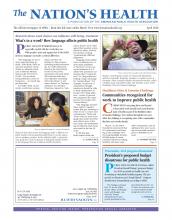With millions of people affected annually by sexual violence, preventing it is a public health priority. Communities, states and public health advocates can take action to stop sexual violence using evidence-based strategies compiled by the Centers for Disease Control and Prevention.
“Stop SV: A Technical Package to Prevent Sexual Violence,” shares strategies to prevent sexual violence and lessen its harms. The strategies promote social norms, teach sexual violence prevention skills, provide opportunities to empower women and girls, create protective environments and support survivors.

Health workers, educators and other partners can use strategies identified by CDC to prevent sexual violence and lessen harms.
Photo by JohnnyGreig, courtesy iStockphoto
Sexual violence is highly prevalent, with 1 in 5 U.S. women experiencing rape or attempted rape during their lifetimes, according to CDC. Almost 40 percent of women have encountered other forms of sexual violence, such as unwanted sexual contact. Among men, almost 11 percent have experienced unwanted sexual contact, with about 47 percent of bisexual men and 40 percent of gay men experiencing some form of sexual violence other than rape, which can include sexual coercion or non-contact unwanted experiences.
To address sexual violence, the technical package calls on public health professionals and their partners to:
Promote social norms to protect against violence: Using a bystander approach, such as encouraging young people to speak up against sexist language and violence-promoting behaviors is advised, as are approaches that involve engaging men and boys as allies.
Teach skills to prevent sexual violence: Helping teens learn healthy, safe dating and intimate relationship skills and providing comprehensive sex education, among other approaches, can be advantageous.
Provide opportunities to empower and support girls and women: Strengthening economic support for women — such as equitable pay, affordable child care and paid leave — can help reduce sexual violence. Providing leadership skills for teen girls can help develop healthy relationships.
Create protective environments: Environmental approaches to addressing sexual violence include improving school safety, establishing policies in the workplace and adopting community policies on excessive alcohol use.
Support victims and survivors: Providing medical and legal services, psychological interventions and treatment for at-risk children and families can lessen harm, according to the technical package.
While the CDC technical package is especially useful to public health workers, other advocates will find it helpful as well. Educators, businesses, social services and government agencies are among the recommended audiences.

A CDC infographic shares information on sexual violence prevention. Strategies include promoting social norms to protect against violence, teaching sexual violence prevention skills and providing opportunities to empower women and girls.
Infographic courtesy CDC
For more information on the resource, visit bit.ly/technicalpackages.
- Copyright The Nation’s Health, American Public Health Association









